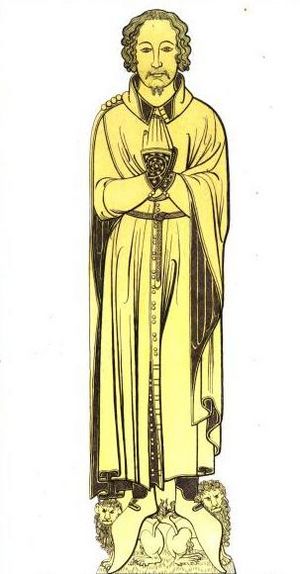Craven Ord facts for kids
Craven Ord (born in 1756, died in 1832) was an English expert in old things, also known as an antiquarian. He was especially famous for his amazing collection of brass rubbings.
Life Story
Craven Ord was born in London in 1756. His father was Harry Ord, and his mother was Anne Hutchinson. His uncle, Robert Ord, was a very important judge in Scotland.
For most of his life until 1829, Craven Ord lived at Greenstead Hall in Essex, near Greenstead Green. Many of his children were born there. He passed away in January 1832 at Woolwich Common.
Craven Ord became a member of the Society of Antiquaries of London in 1775. This is a group for people who study history and old objects. He also joined the Royal Society in 1787, which is a famous group for scientists. For several years, he was a vice-president of the Society of Antiquaries.
What He Did

Craven Ord spent most of his life studying old things. Even though he didn't publish his own books, he wrote for a magazine called Archæologia. Other famous historians, like John Nichols and George Ormerod, thanked him for his help with their books about the history of different English counties.
He also helped Richard Gough with a big book about old tombs called Sepulchral Monuments of Great Britain. In 1780, Craven Ord went on a trip with Gough and Sir John Cullum to find old church brasses in a part of England called East Anglia.
Craven Ord had a special way of making copies of these brasses. He would use damp paper, printer's ink, and rags. First, he would put ink on the brass and then wipe it clean. Next, he would lay the damp paper over the brass. He would cover the paper with thick cloths and then step on it! This would press the ink onto the paper, making a copy. When he got home, he would finish the outlines and cut out the figures. He then pasted them into huge books, some over six feet tall! In 1830, a bookseller bought his amazing collection of brass rubbings.
His Collections and Legacy
Craven Ord's large collection of books and old papers was mostly sold in June 1829. He was leaving England for his health. Some of his important historical papers were sold at this time. For example, a book called Registrum de Bury, temp. Edward III was bought for £126. Another book, Liber Garderobæ ab anno 18 Edw. II ad annum 15 Edw. III, sold for £110 15 shillings. His twenty big books about Suffolk history went to the British Museum, along with many drawings.
Another sale of his old papers happened in January 1830. Many small, old documents were sold in bags. Many of these had belonged to another antiquarian, Thomas Martin, and Ord had bought them cheaply. The collections of other famous collectors, like Francis Douce and Sir Thomas Phillipps, grew a lot from items bought at Ord's sales. The rest of his library was sold after he died in May 1832. At one sale, a monumental brass that had been in Gorleston church was bought by John Gage, who then returned it to the church.
His Family
In June 1784, Craven Ord married Mary Smith. They had five sons and one daughter:
- Rev. Craven Ord (1786–1836): He became a vicar and later a prebendary. He married Margaret Blagrave and inherited his father's property.
- Major Robert Hutchinson Ord: He was in the Royal Artillery and married Elizabeth Blagrave, Margaret's sister.
- Captain William Redman Ord: He was in the Royal Engineers.
- John Ord: He became a doctor.
- Captain Harry Gough Ord: He was the father of Sir Harry St. George Ord, who became a famous governor.
His daughter, Harriot Mary, married Rev. George Hughes in 1815.

